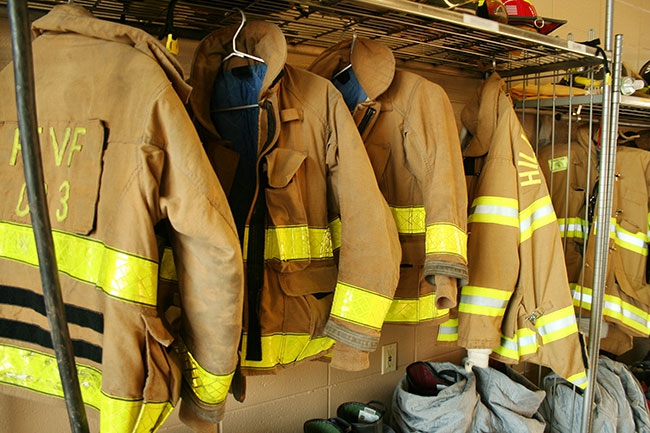
Features
Codes and standards
NFPA Impact: Standard eliminates moisture-barrier test
November 1, 2023
By
Laura King
 Research has shown that soot from fires contains carcinogenic particles that can penetrate bunker gear and must be properly removed. Editor's pick 2016: No. 10 - Soot on bunker gear used to be a badge of honour. Now
Research has shown that soot from fires contains carcinogenic particles that can penetrate bunker gear and must be properly removed. Editor's pick 2016: No. 10 - Soot on bunker gear used to be a badge of honour. NowThere has been a lot of talk about the proposed new standard, NFPA 1970, which, if issued in 2024, will cover bunker gear, work apparel, SCBA and PASS. Essentially, NFPA 1970 consolidates four already-existing standards into one streamlined document, with some changes.
The second draft of 1970 was posted on the NFPA website (nfpa.org/1970) in early October for public comment; anyone could view the draft and recommend changes through a notice of intention to make a motion (NITMAM) until Nov. 1. Proposed NITMAMs accepted by NFPA’s motions committee will become certified amending motions, then go to NFPA’s technical meeting in June for a vote.
There was overwhelming interest in the first draft of the proposed standard during the public input stage. The technical committee for the standard provided extra time for public input to ensure a thorough review of the first draft of NFPA 1970, Standard on Protective Ensembles for Structural and Proximity Firefighting, Work Apparel and Open-Circuit Self-Contained Breathing Apparatus (SCBA) for Emergency Services, and Personal Alert Safety Systems (PASS).
The proposed standard is organized in such a way that chapters one through nine and annexes A, B, G and H comprise NFPA 1971 (bunker gear); chapters one through four, 10 through 14, and annexes A, C and H constitute NFPA 1975 (work apparel); chapters 1 through 4, 15 through 19, and annexes A, D, and H make up NFPA 1981 (SCBA); and chapters 1 through 4, 20 through 24 and annexes A, E, F and H are NFPA 1982 (PASS).
According to an NFPA Xchange blog by Christian Dubay, NFPA’s vice-president, engineering and research and chief engineer, the technical committee for NFPA 1970 has made the following changes to the second draft of the proposed standard based on public input:
- Removal of the xenon arc light test, not just as a stand-alone test method as proposed in the first draft of NFPA 1970, but also from the proposed multi-conditioning procedure (9.1.2.1)
- Additionally, the committee substantively changed the multi-conditioning procedure, which they described as intended to replicate the wear and tear a typical outer shell may experience (9.1.21)
- Added explanatory material for the definition of per- and polyfluoroalkyl substances (PFAS), explaining that the measurement of PFAS in the standard is performed to report the total levels of PFAS in protective clothing materials and measuring levels of specific PFAS chemicals against restricted substance levels (A.3.3.133)
- Added specific testing requirements to verify a manufacturer’s PFAS-free gear claim. (6.5.1)
- Added a requirement to make reported test results available as part of the user information. (6.5.12, 8.14.3, & Table 8.21(a))
- Revised the procedure and application for contamination removal efficiency testing introduced in the first draft (9.9.3)
- Updated a list of restricted substances (8.21, 9.10)
- Added a more extensive listing of requirements for per- and polyfluorinated compounds, including tests for total fluorine and total extractable organic fluorine (8.21, 9.10)
- Added of a new test method for liquid barrier performance, as measured by impact penetration and hydrostatic penetration, to protect against bloodborne pathogens (9.11)
- Removed the tests for liquid repellency and for leaching of material substances (9.76 and 9.77 in the first daft)
To view the second draft report, go to nfpa.org/1970 and click Next Edition.
Queries about the second draft can be submitted through nfpa.org/1970 by clicking Ask a Technical Question.
To stay on top of NFPA 1970 as it makes its way through the standards development process, go to nfpa.org/1970 and click Receive email alerts.
For more detail about what’s in the proposed standard and why, scroll down further at nfpa.org/1970 to find First Draft Committee Information and Second Draft Committee Information. Technical committees minutes and notes can be downloaded.
As Dubay wrote in an earlier blog about 1970, NFPA does not create the standards, rather NFPA facilitates the standards development process.
To be part of a technical committee for a standard that interests you, click on Technical Committees, or email me at Lking@nfpa.org.
Laura King is NFPA regional director for Canada. Contact her at lking@nfpa.org.
Print this page
Advertisement
- Tackling a historic fire in Vaughan
- Career Expo West 2023: Expanding horizons for emergency services and aviation professionals